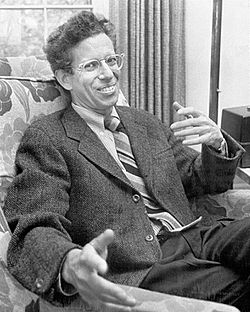Howard Temin facts for kids
Quick facts for kids
Howard Martin Temin
|
|
|---|---|

Temin in 1975
|
|
| Born | December 10, 1934 |
| Died | February 9, 1994 (aged 59) |
| Occupation | Geneticist |
| Known for | Nobel Prize in Physiology or Medicine in 1975 |
Howard Martin Temin (December 10, 1934 – February 9, 1994) was an American scientist. He was a geneticist, which means he studied how living things pass on traits. He is famous for winning the Nobel Prize in Physiology or Medicine in 1975. He shared this important award with two other scientists, David Baltimore and Renato Dulbecco.
Temin made a groundbreaking discovery about how certain viruses work. He showed that some viruses, especially those that can cause tumors, have a special ability. They can turn genetic information from RNA back into DNA. This process uses a unique enzyme called reverse transcriptase. His discovery changed how scientists understood how genes and viruses behave.
Who was Howard Temin?
Howard Martin Temin was born in Philadelphia, Pennsylvania, on December 10, 1934. Even from a young age, he was very interested in science. He went to college at Swarthmore College and then studied at the California Institute of Technology. There, he earned his PhD in biology.
After his studies, Temin became a professor at the University of Wisconsin–Madison. He spent most of his career there, doing important research. He was known for his careful experiments and his new ideas.
What was his big discovery?
For a long time, scientists believed that genetic information always flowed one way. They thought it went from DNA to RNA, and then to proteins. This was called the "central dogma" of biology.
But Howard Temin found something different. He studied retroviruses, which are a type of virus. He discovered that these viruses could do the opposite. They could take their RNA and use a special enzyme to make DNA from it. This enzyme was named reverse transcriptase.
This discovery was very important because it showed that the flow of genetic information was not always one-way. It helped scientists understand how retroviruses, like the ones that cause some cancers, work. It also opened up new ways to study genetics and develop new medicines.
Why was it important?
Temin's discovery of reverse transcriptase had a huge impact on science.
- It helped us understand how certain viruses, including those that cause diseases, infect cells.
- It led to new tools for genetic engineering. Scientists can now use reverse transcriptase to study genes and create new DNA.
- It was a key step in understanding viruses like HIV, the virus that causes AIDS. Reverse transcriptase is essential for HIV to multiply.
For his amazing work, Howard Temin was awarded the Nobel Prize in Physiology or Medicine in 1975. He passed away on February 9, 1994, but his discoveries continue to influence science today.
See also
 In Spanish: Howard Martin Temin para niños
In Spanish: Howard Martin Temin para niños

